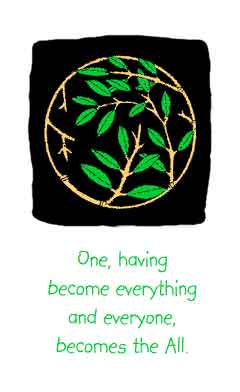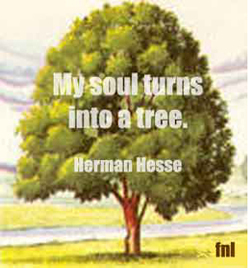| Bringing back the Spirit of the Wolf
"I love symphs," says Mary Leontovich of the OSU Extension Service, then, with more emphasis: "They're our friends." Hers is not the only voice within the OSU system singing a contrary note into a discussion which typically considers symphs in terms, elementally, of a pathology. Pat Patterson, also with the Extension Service: "I wouldn't want to destroy them in the soil," she says. "They're only a problem where they're concentrated. Symphs are like pigs; typically very picky eaters. It's only when you force them into factory farms that they'll eat anything that comes their way. Nibbling and browsing is the normal pattern in nature. It's only man who clearcuts, or sets up the conditions for it." Perhaps the views of these two, both women and both gardeners, hint at the beginnings of a broader shift in perspective toward the symph that may yet hold the secret to embracing it as an ally, rather than an enemy. As Manusoba Fukuoka puts it: "The Great Way has no pests, no disease. Only faults when seen in parts." |
||||||||||||||||||||||||||||||||||||||||||||||||||||||||||||||||||||
| Romantic as the notion might initially appear to veggie farmers losing their shirts to symph damage, widening the terms of the symph debate to include the potential for a fundamental shift in agricultural thinking, may yet allow us to embrace the symph as a friend. As permaculturist Toby Hemenway (see box) describes its: "When we think ecologically, the problem either evaporates as a misunderstanding, or reveals solutions inherent in the life cycle of the invader." Carl Berg of Berg's Berries, farms land where symphs emerged as a big problem in the 70's. Faced with a 2 1/2 to 3 acre symph-heavy plot that consisently resisted all efforts to successfully plant it with strawberries, he simply turned the field over to peach trees. "I've had no problems with symphs there since." Berg's choice makes a nod toward the work of the visionary permaculture community. Permaculture, by definition a whole systems approach to landscape stewardship, resists all easy attempts at capsule description. In essence, it stands on the premise that landscapes have an irresistible tendency to mature - so why not hop on board the successionary freight train and take advantage of nature's momentum? Permaculturally speaking, concentrated symph populations are a pointer to the successionary direction a landscape wishes to "free itself into." |
 |
|||||||||||||||||||||||||||||||||||||||||||||||||||||||||||||||||||
|
Paradoxically then, in evolutionary terms, symph infestation can be seen as symptomatic of a drift into deeper health. Of course, whether or not we resist the terms of that call, or find a way to go with the flow, is up to us. Take the symph story, for example. Central to a permacultural understanding of the symph is an understanding of the genius of evolutionary time. How does this relate to agriculture? In a nutshell, conventional organic agriculture mimics immature ecosystems. Conventional farms are usually dominated by early succession plants - grasses, annual vegetables and flowers are pioneers. A typical farm field is aching, in nature's scheme, for a chaotic blitzkrieg from seedlings, shrubs and animal life forms. Viewed ecologically, the standard farm landscape just wants to grow up. Meanwhile, we expend an enormous amount of time, energy and material wrenching back the hand of the ecological clock, constantly uprooting plants, culling diversity, holding the land "back". Yet nature - and our irrigation and amendments ñ will inexorably advance the clock another tick, inundating us with her fertility. On the one hand we're stamping on the accelerator: on the other, we're slamming on the brake. "No system runs well under that kind of schizophrenic regime,"says Hemenway. |
||||||||||||||||||||||||||||||||||||||||||||||||||||||||||||||||||||
 |
Of course, the tension that exists between nature's successionary instincts and the demands of commercial agriculture isn't news to farmers. "Of course the aim in "modern" ag is sameness, so that a field can yield consistently one crop at a time," says Wali Via of Wintergreen Farm. "Lots much change for that paradigm to shift for the majority of USA's food production, but of course that's what's needed." The permaculture community has been making efforts to explore the technes involved in letting go to this evolutionary leap. A key understanding is that moving in such a direction involves shifting as much of the labor as possible onto Nature's broad back. And the essence of this, the permies have discovered, involves promoting deeper biodiversity - for our purposes, biodiversity means having a semi-wild but well-designed palette of useful plants that will attract and sustain the helpful plants, insects, birds and other animals we need. Permaculture's art is in exploring designs that serve these functions synergistically - finding a combination that "clicks." |
|||||||||||||||||||||||||||||||||||||||||||||||||||||||||||||||||||
| Put another way, the work of managing a biodiverse "food forest"is so complex, the only way it can be done is by shedding the mantle of command and returning to nature many responsibilities we have long assumed. And what we're finding, is that it works, because in a many specied landscape, we are able to restore many of the torn threads that nurture nature's self-organizing, self-repairing and self-perpetuating energies. And, of course, it just so happens that "letting nature do it"also applies to dealing with pests, because in the midst of rich biodiversity the supporting thread of interconnections also acts as a natural web of checks and balances.
Elementally, ushering these dynamics into farmlands requires embracing the advantages of mature landscapes that emphasize perennials (see table). "We know that symphs love the roots of young plants, " says Dancing Tree Farms' Kris Dicus, who is new to farming cropland he knows has endured heavy symph damage for more than 30 years, "We know perennials are going to have a much stronger root system and that in many instances the roots will go deeper than the symphs go. We see perennials in the middle of symph patches doing fine. So we're adding perennials, trees and suchlike. But continuing to go with annuals, keeping in mind that we still need to plant enough for ourselves, the symphs and other critters who insist on sharing our own crops." |
||||||||||||||||||||||||||||||||||||||||||||||||||||||||||||||||||||
|
||||||||||||||||||||||||||||||||||||||||||||||||||||||||||||||||||||
 |
Mark van Horn concurs: "I have had a similar thought, namely a very different agro-ecosystem. Two ideas are a flooded crop - for example, rice in our location - or perennials, which could be fruit trees, vines, and woody herbs, and suchlike."
Of course, it's a shift that flies in the face of accepted ag wisdom. As Elaine Ingham, President and Director of Research at Soil Foodweb Inc. in Corvallis puts it: "Just how do you get your tractor through a field with the occasional tree?" and Mark van Horn again: "The rice and perennials idea may be intriguing to you and I, but a veggie farmer probably doesn't consider these real options." |
|||||||||||||||||||||||||||||||||||||||||||||||||||||||||||||||||||
|
One area being explored by Jude Hobbs of Cascadia Forest Design is the use of hedgerows. Hobbs, based in Eugene and also a guiding force in the Pacific Northwest permie set, has emerged as one of the country's foremost authorities around the richly complex subject of hedgerow plantings. |
||||||||||||||||||||||||||||||||||||||||||||||||||||||||||||||||||||
 |
Multi-Functional Hedgerow at Wintergreen Farm |
|||||||||||||||||||||||||||||||||||||||||||||||||||||||||||||||||||
|
Of course, the combination of plants you may choose to introduce to your symphs may look nothing like Wintergreen's hedgerow guild. Your preferences and your land will largely determine that. But how do you begin setting about introducing deeper diversity into your landscape? |
||||||||||||||||||||||||||||||||||||||||||||||||||||||||||||||||||||
 |
||||||||||||||||||||||||||||||||||||||||||||||||||||||||||||||||||||
|
Hemenway calls these communities "polycultures."In their more sophisticated forms, the plants themselves tune their environment to the best conditions for their growth - we can think of ecosystems as very intricate polycultures - with the interconnected elements far greater than the sum of stand-alone parts. But even at the smaller scale we can work at, plant "guilds"can demonstrate the characteristics of the systems in which they are nested - qualities such as succession, predator-prey relations, climate control, and so on. And as one might expect, these guilds also exhibit the same qualities that make these mini-ecosystems far more robust, more adaptive, and less prone to disaster than most human-designed systems. |
||||||||||||||||||||||||||||||||||||||||||||||||||||||||||||||||||||
|
The art of fashioning polycultures is essentially the art of attuning ourselves to billions of years of evolutionary wisdom. And when it works, boy does it work. "The early establishment phase can take a couple of years, but then look out! The whole place suddenly "pops"as if some critical mass has been reached,"says Hemenway. "Everyone who practices permaculture and ecological gardening for a few years has seen this amazing transformation." Until now, this trick of the trade is what has fundamentally distinguished permies from their ag cousins - the focus on strategies that strengthen synergies to the point where, in a seeming instant, the landscape suddenly surges into vital action, exploding with living energy. How well agriculturists are able to fully embrace permie's technes as an integral part of their own practice, only time will tell, but perhaps Wali Via at Wintergreen Farm has an inkling of the potency of the potential communion when he says, "I've long said that the future of agiculture is in the hands of the gardeners." |
 |
|||||||||||||||||||||||||||||||||||||||||||||||||||||||||||||||||||
|
The above written for Oregon Tilth. Words and art by n. |
||||||||||||||||||||||||||||||||||||||||||||||||||||||||||||||||||||